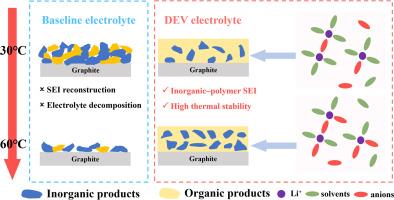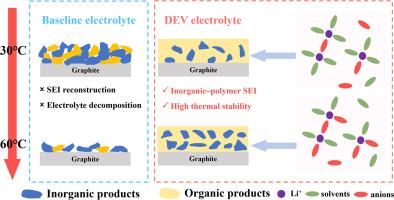The high-temperature adaptive interfacial chemistry engineering of sulfolane-based electrolytes enables long-cycle lithium-ion batteries under extreme temperatures (≥80 °C)
IF 20.2
1区 材料科学
Q1 CHEMISTRY, PHYSICAL
引用次数: 0
Abstract
With the growing demand for lithium-ion batteries (LIBs) capable of reliable operation under extreme high-temperature conditions (≥60 °C), conventional carbonate-based electrolytes face critical limitations due to thermal instability and interfacial degradation. In this study, we develop a sulfolane (SL)-based electrolyte incorporating fluorine-free vinylene carbonate (VC) as a functional additive to construct a high-temperature adaptive interfacial chemistry strategy. VC, featuring moderate coordination ability and interfacial passivation capability, enables controllable formation of thermally stable solid electrolyte interphases (SEIs). Systematic analysis reveals that increasing temperature induces a transition from solvent-separated ion pairs (SSIPs) to contact ion pairs (CIPs) and aggregated ion clusters (AGGs), which promotes the formation of a composite SEI comprising LiF-rich inorganic phases and poly(VC) networks. The interwoven SEI exhibits excellent mechanical integrity, thermal robustness, and facilitates efficient Li⁺ transport. Electrochemical evaluations demonstrate that the SL-based electrolyte enables graphite half-cells to retain 95.89 % of capacity after 200 cycles at 60 °C, and pouch cells (NCM523||graphite) maintain 89.55 % of capacity after 1000 cycles at 60 °C, outperforming conventional systems. These results highlight the potential of SL-based electrolytes for safe and long-lasting high-temperature LIB applications.


磺胺基电解质的高温自适应界面化学工程使锂离子电池在极端温度(≥80 °C)下实现长循环。
随着对能够在极端高温条件下(≥60 °C)可靠运行的锂离子电池(lib)的需求不断增长,传统的碳酸盐基电解质由于热不稳定性和界面降解而面临关键限制。在本研究中,我们开发了一种以亚砜(SL)为基础的电解质,以无氟碳酸乙烯(VC)为功能添加剂,构建了高温自适应界面化学策略。VC具有适度的配位能力和界面钝化能力,可以可控地形成热稳定的固体电解质界面相(SEIs)。系统分析表明,温度升高诱导了从溶剂分离离子对(SSIPs)到接触离子对(cip)和聚集离子簇(AGGs)的转变,促进了由富liff无机相和聚(VC)网络组成的复合SEI的形成。交织的SEI具有优异的机械完整性和热稳健性,并有利于Li⁺的高效传输。电化学评估表明,在60 °C下,基于slb的电解质使石墨半电池在200次循环后保持95.89%的容量,而袋状电池(NCM523||石墨)在60 °C下循环1000次后保持89.55%的容量,优于传统系统。这些结果突出了基于sl的电解质在安全和持久的高温LIB应用中的潜力。
本文章由计算机程序翻译,如有差异,请以英文原文为准。
求助全文
约1分钟内获得全文
求助全文
来源期刊

Energy Storage Materials
Materials Science-General Materials Science
CiteScore
33.00
自引率
5.90%
发文量
652
审稿时长
27 days
期刊介绍:
Energy Storage Materials is a global interdisciplinary journal dedicated to sharing scientific and technological advancements in materials and devices for advanced energy storage and related energy conversion, such as in metal-O2 batteries. The journal features comprehensive research articles, including full papers and short communications, as well as authoritative feature articles and reviews by leading experts in the field.
Energy Storage Materials covers a wide range of topics, including the synthesis, fabrication, structure, properties, performance, and technological applications of energy storage materials. Additionally, the journal explores strategies, policies, and developments in the field of energy storage materials and devices for sustainable energy.
Published papers are selected based on their scientific and technological significance, their ability to provide valuable new knowledge, and their relevance to the international research community.
 求助内容:
求助内容: 应助结果提醒方式:
应助结果提醒方式:


